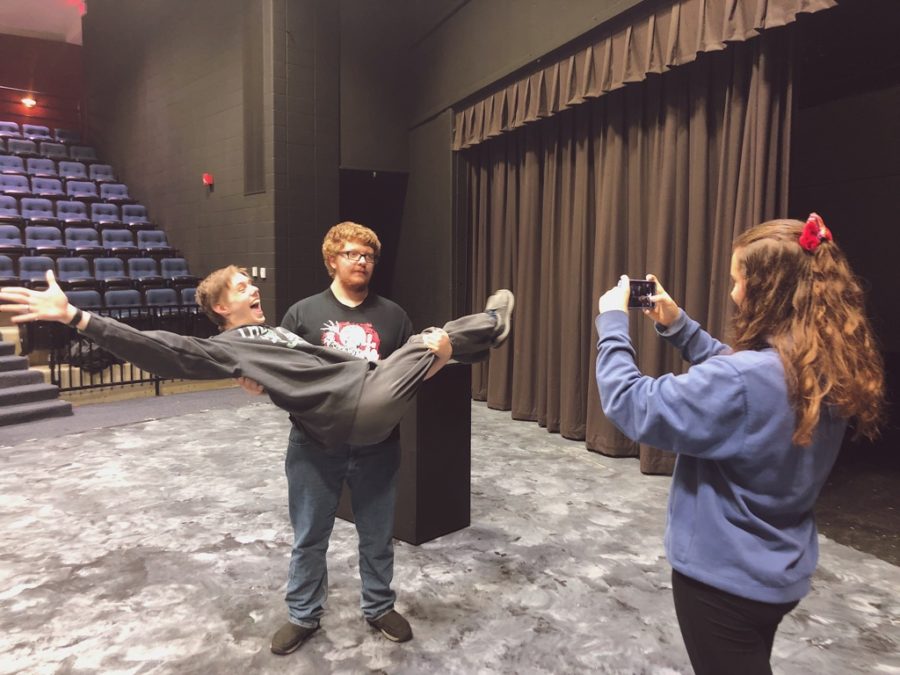After one year preparing and researching, theater department Head Amie Gossett began teaching a new fine art course titled Cinematography and Screenwriting.
The idea for the class arose at a meeting of fine art department leaders in the district discussing the sequence of classes, and what could potentially lead into the Advanced Broadcasting class.
“I suggested that we have a screenwriting or cinematography class or both, and somehow in the discussion of the meeting we decided that we were going to do this class and that I was going to pilot it for the district and develop the curriculum for it,” Gossett said. “That way there is a track for kids to go the film route to Broadcasting and Production.”
To plan the curriculum, Gossett obtained information through books, online resources and guidance from other teachers. English teacher Dan Barnes had experience with teaching and scoring screenplays as part of his Creative Writing curriculum, and values the takeaways screenwriting provides for students.
“I think there is great value in the sort of structured, technical writing that comes from screenwriting,” Barnes said. “It allows students to be creative in a structured format and forces them to be aware of their audience.”
After looking over Barnes’ previous rubrics and approaches to teaching these topics, as well as further research, Barnes and Gossett mapped out the curriculum for Cinematography and Screenwriting.
“I took some classes and pulled some resources over the summer. Before I left for a weeklong workshop I went to, Mr. Barnes and I sat down and created the curriculum,” Gossett said. “We had the curriculum down and had collected our thoughts on it, then I went to this film camp and texted him when I was there and was like ‘hey guess what? We’re going to meet again and we’re going to completely redo this.”
Following this realization, Gossett planned the current curriculum in order to best meet the needs of students and eventually allow for an Advanced Cinematography and Screenwriting class to provide greater opportunity for more extensive projects in the future.
“We’re taking small, attainable things that hold a lot of information and require a lot of thought in creation, but not a lot to produce,” Gossett said. “That’s the way we’ve approached it so that if kids did sign up for Advanced, they have a package of the basics that can expand.”
While senior Derek Isele will not be able to fully experience the path Gossett has planned for students interested in film, he values the opportunity of being able to take the class his final semester of high school.
“I do want to go on to become a screenwriter, so I’m doing this [class] and then going off to college so I’ll have all of the information fresh in my mind,” Isele said.
Sophomore Sarenna Wood believes this class could help guide her as she is less certain of her future career path.
“In eighth grade I directed a one-act and it was really fun, so I always thought it would be interesting to get into directing. I really don’t know much about movies, so I thought this would be a good opportunity to learn more,” Wood said.
Gossett hopes students who elect to take Cinematography and Screenwriting will not only learn about movies and filmmaking, but transferable skills for any path beyond high school.
“Ultimately, I want kids to be able to have something to put into a portfolio to get them further in life,” Gossett said. “Those are things employers and colleges are looking for, even if it’s not that they’re interested in pursuing a film career, they’re still obtaining skills to help them later in life, and that’s how I think all classes should be approached.”




![Gazing up from the stage, junior Joseph McCurdy who played Peter Pan in the school play, Lost Girl, sits next to senior Juliana Rogers, who plays Wendy Darling, during a theater rehearsal. McCurdy’s passion for theater began when he observed a West High production in middle school. “I've been in the high school theater program since I was a freshman. I've always loved theater, but [what prompted me to join] was [when] I went to see [a performance here] when I was in middle school, and it was super cool,” McCurdy said.](https://pwestpathfinder.com/wp-content/uploads/2025/11/IMG_6535-1200x798.jpeg)

![Standing tall, stacked in a precise formation, the cheer team strikes a signature pose during halftime on Sept. 12 at the varsity football game. Nearly a month after this performance, the cheer team performed at the Missouri Cheerleading Coaches Association (MCCA) regional competition on Oct. 4, 2025. “We've all come [to] work together a lot more,” sophomore Elyssa Philippi said. “We're a lot closer than we were [earlier in the season] and going to state has made us closer [in] trying to work with each other, learn [new] skills and make our team better.”](https://pwestpathfinder.com/wp-content/uploads/2025/11/DSC5139-1.jpg)
![Handing out candy to excited trunk-or-treaters, President of the United Nations Children’s Fund club and junior Sara Ashok represents that group. Ashok was eager to participate in this event for multiple reasons. “I really wanted to be a part of the event because I get to help create memories for kids and spend time with my friends, spreading the things [I'm passionate about],” Ashok said.](https://pwestpathfinder.com/wp-content/uploads/2025/11/DSC_8648-1-1200x800.jpg)

![Smiling in a sea of Longhorns, Fox 2 reporter Ty Hawkins joins junior Darren Young during the morning Oct. 3 pep rally. The last time West was featured in this segment was 2011. “[I hope people see this and think] if you come to [Parkway] West, you will have the time of your life because there are so many fun activities to do that make it feel like you belong here. I was surprised so many people attended, but it was a lot of fun,” Young said.](https://pwestpathfinder.com/wp-content/uploads/2025/10/Edited2-1200x798.jpg)
![West High seniors and families listen as a representative of The Scholarship Foundation of St. Louis, Teresa Steinkamp, leads a Free Application for Federal Student Aid (FAFSA) workshop. This session, held in the library, provided guidance on financial aid, scholarships and student loan options. “This event is very beneficial for any seniors who are applying to or considering applying to colleges after high school [because] the cost of college is on the rise for seniors and parents,” college and career counselor Chris Lorenz said.](https://pwestpathfinder.com/wp-content/uploads/2025/09/DSC_4478-1200x778.jpg)
![Senior Kamori Berry walks across the field during halftime at the Homecoming football game on Sept. 12. During the pep assembly earlier that day, she was pronounced Homecoming Queen. “I thought it was nice that the crowd [started] cheering right away. I know [my friends] were really excited for me, and my family was happy because typically non-white people don't win,” Berry said.](https://pwestpathfinder.com/wp-content/uploads/2025/09/DSC7046-Enhanced-NR-1200x798.jpg)


